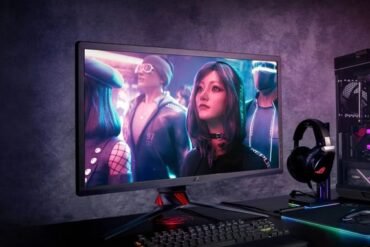Graphics Card Connectors: Display Options for Gamers
Table of Contents
HDMI vs. DisplayPort: Choosing the Best Connection
When it comes to connecting your graphics card to your display, you have several options to choose from. Two of the most popular choices are HDMI (High-Definition Multimedia Interface) and DisplayPort. Both of these connections offer high-quality audio and video transmission, but there are a few key differences that gamers should be aware of.
HDMI:
- HDMI is widely used and supported by most consumer electronics, making it a popular choice for connecting gaming consoles, televisions, and monitors.
- It supports high-definition video and audio, including 4K resolution at 60Hz.
- HDMI connections are easy to use, with a simple plug-and-play setup.
- Some HDMI cables also support Ethernet and ARC (Audio Return Channel) functionality, allowing for additional connectivity options.
DisplayPort:
- DisplayPort is a newer connection standard that offers higher bandwidth and supports higher refresh rates.
- It is commonly found on gaming monitors and high-end graphics cards.
- DisplayPort supports 4K resolution at 120Hz and even higher resolutions, making it ideal for gamers looking for a smooth and immersive gaming experience.
- It also supports multi-stream transport (MST), which allows you to connect multiple displays using a single DisplayPort connection.
Choosing the Best Connection:
When deciding between HDMI and DisplayPort, consider your specific needs and the capabilities of your graphics card and display. If you’re using a TV or monitor with HDMI ports and don’t require high refresh rates beyond 60Hz, HDMI may be the more convenient and widely compatible choice. However, if you’re a serious gamer looking for the best possible performance and have a graphics card and monitor that support DisplayPort, opting for DisplayPort can provide you with a smoother and more immersive gaming experience.
Ultimately, both HDMI and DisplayPort are excellent choices for connecting your graphics card to your display. Assess your requirements and choose the one that best suits your needs.
DVI and VGA: Legacy Options for Older Monitors
As technology advances, so do display options for gamers. However, not all monitors keep up with the latest connectors that come with modern graphics cards. For those with older monitors, there are still legacy options available, such as DVI and VGA.
Digital Visual Interface (DVI) is a common connector found on older monitors. It supports both analog and digital signals, making it versatile for various display resolutions. DVI-I (integrated) supports both analog and digital signals, while DVI-D (digital) only supports digital signals. DVI-A (analog) is the least common type and only supports analog signals.
VGA (Video Graphics Array) is an even older connector that was widely used before digital displays became popular. It is an analog-only connector and supports lower display resolutions compared to DVI. VGA is often associated with lower image quality and can suffer from signal degradation over longer cable lengths.
When connecting an older monitor to a modern graphics card, using DVI or VGA requires the appropriate adapter or cable. Graphics cards typically come with DVI-I or DVI-D connectors, so it is usually easier to find the necessary adapters for DVI monitors. VGA adapters are also readily available, but it’s important to note that converting a digital signal to analog (DVI to VGA) or vice versa can result in a slight loss of image quality.
- One advantage of using DVI or VGA is that they are still widely supported by many graphics cards, ensuring compatibility with older monitors.
- These legacy connectors can be more affordable compared to newer options such as HDMI or DisplayPort.
- For gamers with older monitors, using DVI or VGA allows them to continue enjoying their favorite games without the need for a monitor upgrade.
However, it’s important to keep in mind that DVI and VGA are becoming increasingly outdated as newer connectors offer superior image quality and higher display resolutions. If you have an older monitor and are considering an upgrade, it may be worth exploring newer options such as HDMI or DisplayPort for a more immersive gaming experience.
Ultimately, the choice between DVI, VGA, or upgrading to a newer monitor depends on individual preferences, budget, and the desired gaming experience. Regardless of the connector choice, gamers can still enjoy their favorite games with older monitors, thanks to the legacy options provided by DVI and VGA.
Exploring USB-C: The Versatile Connector for Gaming
When it comes to graphics card connectors for gaming, one option that has gained popularity in recent years is USB-C. Originally developed as a universal connector for various devices, USB-C has proven to be a versatile and efficient choice for gamers.
USB-C offers several advantages over traditional connectors such as HDMI and DisplayPort. Firstly, it provides faster data transfer speeds, allowing for smoother gameplay and reduced latency. This is especially important for competitive gamers who rely on quick response times.
In addition to faster data transfer, USB-C also supports higher resolutions and refresh rates, providing gamers with a more immersive and visually stunning experience. With USB-C, you can enjoy gaming on a 4K monitor at 60Hz or even higher, depending on the capabilities of your graphics card.
Another benefit of USB-C is its ability to carry both video and audio signals. This means you can connect your gaming setup to a monitor or TV with a single cable, eliminating the need for multiple connectors and simplifying cable management.
Furthermore, USB-C is a reversible connector, making it incredibly easy to plug in and remove. Gone are the days of fumbling around to find the right orientation – simply insert the USB-C cable and you’re good to go. This convenience is particularly useful during gaming sessions, where every second counts.
It’s worth noting that while USB-C is a versatile connector, not all graphics cards come equipped with a USB-C port. However, you can easily find adapters and converter cables to connect your USB-C enabled devices to your graphics card.
In conclusion, USB-C is a fantastic option for gamers looking for a versatile and efficient connector. With its faster data transfer speeds, support for higher resolutions and refresh rates, ability to carry both video and audio signals, and convenient reversible design, USB-C is a great choice for gaming enthusiasts. So, if you’re in the market for a new graphics card or considering upgrading your gaming setup, be sure to explore the possibilities that USB-C has to offer.
The Importance of Multiple Monitor Support
In the world of gaming, having multiple monitors can significantly enhance your gaming experience. With the right graphics card connectors and support for multiple monitors, gamers can enjoy a wider field of view, improved immersion, and increased productivity. Here’s why having multiple monitor support is crucial for gamers:
- Wider Field of View: One of the main advantages of using multiple monitors is the ability to expand your field of view. By extending your display across multiple screens, you can see more of the game world without the need to constantly pan the camera or adjust the in-game settings. This wider field of view can give you a competitive edge by allowing you to spot enemies or important game elements that would otherwise be off-screen.
- Improved Immersion: Gaming is all about immersing yourself in a virtual world, and having multiple monitors can greatly enhance that experience. With a multi-monitor setup, you can create a more immersive environment by surrounding yourself with the game’s visuals. This can make you feel more connected to the virtual world and enhance your overall gaming experience.
- Increased Productivity: Multiple monitor support is not just beneficial for gaming; it can also boost productivity. With a multi-monitor setup, you can have different applications or information displayed on each screen, allowing you to multitask more efficiently. Gamers can easily monitor chats, streams, or guides on one screen while playing the game on the other, improving their overall gaming performance.
To make the most of multiple monitors, gamers need a graphics card that supports multiple display connectors. Common graphics card connectors include HDMI, DisplayPort, and DVI. It’s important to ensure that your graphics card has the necessary connectors to support the number of monitors you plan to use. Additionally, the graphics card should have sufficient power and memory to handle the increased demands of multiple displays.
In conclusion, having multiple monitor support is essential for gamers who want to enhance their gaming experience, increase their productivity, and improve their immersion in virtual worlds. By investing in a graphics card with the right connectors and capabilities, gamers can enjoy the benefits of a multi-monitor setup and take their gaming to the next level.
Understanding Graphics Card Connectors: A Comprehensive Guide
When it comes to gaming, having a high-quality graphics card is essential for an immersive and visually stunning experience. However, understanding the different types of graphics card connectors can be confusing for many gamers. In this comprehensive guide, we will break down the most common graphics card connectors and their display options to help you make an informed decision.
1. HDMI (High-Definition Multimedia Interface)
- HDMI is the most widely used graphics card connector for both gaming and multimedia purposes.
- It provides high-quality audio and video transmission in a single cable.
- HDMI supports resolutions up to 4K, making it ideal for modern gaming.
2. DisplayPort
- DisplayPort is another popular graphics card connector that offers high-resolution audio and video transmission.
- It supports 4K and even 8K resolutions, making it future-proof for gaming.
- DisplayPort also supports multi-monitor setups, allowing for a seamless gaming experience across multiple screens.
3. DVI (Digital Visual Interface)
- DVI is an older graphics card connector that is still commonly found on many monitors.
- It supports both analog and digital signals, but the analog support is gradually being phased out.
- DVI is capable of supporting high resolutions, but it lacks the audio transmission capability found in HDMI and DisplayPort.
4. VGA (Video Graphics Array)
- VGA is the oldest graphics card connector and is rarely found on modern gaming graphics cards.
- It supports analog signals and has lower resolution capabilities compared to HDMI, DisplayPort, and DVI.
- While VGA may still be usable for older monitors, it is not recommended for gaming due to its limited capabilities.
5. USB Type-C
- USB Type-C is a versatile connector that can support graphics card connectivity through the use of appropriate adapters or docking stations.
- It offers high-speed data transfer and power delivery options, making it a convenient choice for gamers with compatible devices.
- USB Type-C is becoming increasingly common in newer graphics cards and monitors.
Understanding the different graphics card connectors and their display options is crucial for selecting the right setup for your gaming needs. Consider the resolution, audio requirements, and compatibility with your monitor or display device when choosing a graphics card connector. By making an informed decision, you can enhance your gaming experience and enjoy stunning visuals.


























